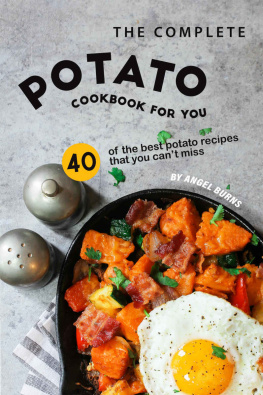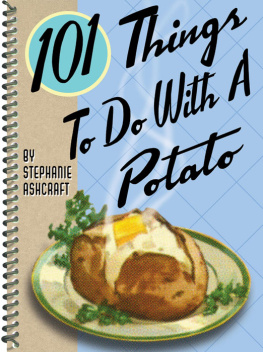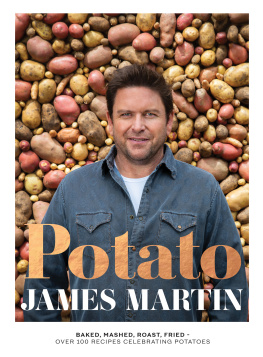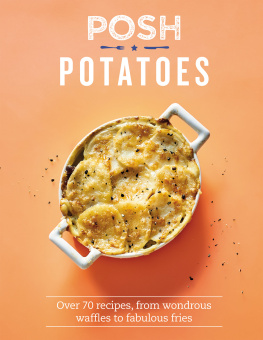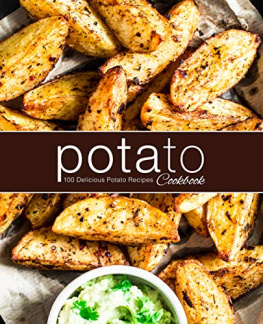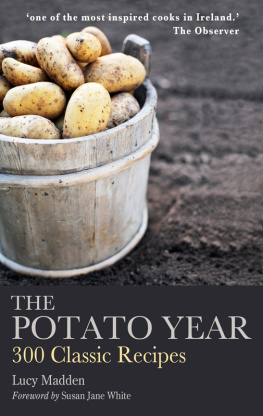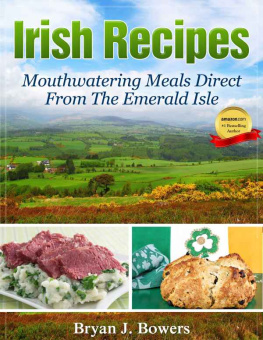Irish Potato
Cookbook
Eveleen Coyle
Gill & Macmillan
Contents
Introduction
N othing can beat a pot of floury potatoes served with melting butter. But really they are at their best for only a few months of the year. In Ireland we love potatoes and eat them almost every day, all year round. Nutritious, rich in vitamin C, potassium and protein and low in cholesterol, potatoes should be a staple part of everyones diet.
Assembling recipes for this book, it became clear how much our attitude to cooking generally and to potatoes in particular, has changed over the last decade. The combination of outside influences, traditional recipes-we-all-grew-up-with, and the necessity of putting a meal on the table for six people, six days a week: all these factors shaped the approach to cooking potatoes in my own household.

When the potato was introduced to Ireland in the early 17th century, it changed our whole way of life. Grown from seed potatoes laid in trenches or drills, the potato suited the stony and boggy land in a way that corn and grain crops, so popular in Europe, did not. Potatoes were less vulnerable to coastal winds and the yield was high. They grew in trenches, and trenches created good drainage on bogs. Drills could be dug in the most awkward bit of a field or on the seemingly inaccessible part of a mountain. A tiny plot could feed a family and help pay the rent, so small farmers quickly became dependent on potatoes.
By 1840, one-third of crops grown were potatoes. In 1845, potato blight hit Europe and spread swiftly to Ireland, destroying the crops for three years in a row. Over a million people died and many more emigrated. Walking anywhere in the West of Ireland today, the distinctive pattern of potato trenches abandoned since the Famine of 1845 is still clearly visible.
The range of potatoes available on the Irish market is vast and increasing all the time. The most common of the main-crop varieties are Home Guard (first early), Golden Wonders (my own favourite of the late main crop potatoes), Records,
Kerrs Pink, Pentland Dell, King Edwards, Arran and more recently, Roosters. In Ireland generally, we tend to prefer good floury potatoes rather than the waxy varieties favoured in other European countries.
This book both reflects our traditional cooking and acknowledges those recipes from friends, family, magazines and favourite cookery writers. Wherever I remember a source it is mentioned; some recipes have changed so much with use that they barely resemble the original.
Enjoy them all!
Buying and storing
- It is essential to choose carefully the best quality potatoes and to store them well.
- It is best to buy potatoes in small quantities that you will use quickly.
- Look for firm potatoes with no damp patches or wrinkly bits.
- Keep them in a dark, cool, airy place.
- If they are bought in plastic bags, remove the potatoes from the bag once you get home.
- Potatoes bruise easily so treat them gently.
Cooking tips
- As a general rule, allow about 225 g/8 oz of potatoes per person, but use your common sense and bear in mind the people you are feeding, how you are cooking the potatoes, and what you are serving them with, and adjust your quantities accordingly.
- The same applies to cooking times and temperatures; take into account the size of the potatoes and the vagaries of your own oven.
- Try steaming potatoes rather than boiling them, particularly new potatoes.
- If you do boil them, pour on boiling water, return to the boil straight away and watch them carefully.
- Use as little water as possible because it steals nutrients from the potatoes.
- With older potatoes, start in lightly salted cold water and bring to the boil.
- A little fresh mint or a squeeze of lemon juice prevents after-cooking discolouring.

- Do not prepare potatoes in advance; above all, do not peel and leave them sitting in water for any length of time. If you must get them ready in advance, dry them and put them in a plastic bag in the bottom of the fridge to reduce discolouration.
- Eat potatoes unpeeled as far as possible they are much more nutritious and a lot less trouble.
- If you do peel potatoes, use a sharp potato peeler. Remember the best part is just under the skin so you dont want to lose it.
- When I refer to salt and pepper, I mean good quality sea-salt and freshly ground pepper, black unless specified.
- Always season to your own taste. And taste all the time.
Common varieties available in Ireland
Potatoes tend to fall into three categories:
First Earlies Available June July
Second Earlies Available July August
Main Crop Available September May
- Home Guard a first early crop, white-fleshed potato. They are good for boiling, roasting, and new potato salads.
- Queens second early, delicious floury potatoes, good for all uses.
- Golden Wonder dry, floury, russet-skinned potatoes, one of the best of the late main crop potatoes.
- Kerrs Pink another late main crop potato with a lovely pink skin. Also dry and floury.
- Records main crop potato, dry and floury with yellow flesh.
- Pentland Dell a main crop potato with creamy white flesh, a bit soapy but good for baking, chips etc.
- King Edward another main crop potato with creamy flesh, good for roasting, chipping and boiling.
- Rooster a main crop potato that is good for most methods of cooking.
Soups
S oup can be the best of meals or the most ordinary, depending on your ingredients. A well-made soup is nourishing, inexpensive and satisfying. Soups can be served as a snack, starter or made into a simple meal.
They can also be made in advance, using a variety of ingredients and enhanced with just about any herbs. It is worth keeping white and brown stock and fish stock (frozen in ice-cubes for convenience) in the freezer. Good quality stock cubes are available now, but beware, they are often very salty. A blender is useful for mixing ingredients and getting the right texture, but it is not essential.

Simple, well-made potato soup is quick to prepare and has a lovely flavour. It can also form the base for many other soups.
POTATO SOUP
SERVES 4
This is a traditional soup recipe. It is both useful and tasty and can be served with various garnishes on top: cheese, parsley, chives or streaky rashers, fried crispy and crumbled. A good stock improves the flavour.
- 1 large onion, chopped
- 2 tbsp butter or bacon fat
- 200 g/10 oz potatoes, peeled and chopped
- 900 ml/1 pints/3 cups chicken or beef stock
- 125 ml/4 fl oz/ cup milk or cream
- salt and pepper
- chopped parsley to serve
Sweat the onion in butter, add the potatoes and cook for 10 minutes. Turn them gently and frequently but do not allow them to brown. Add the stock and simmer until the potato is tender. Pure in the blender and add milk or cream. Reheat, check the seasoning, stir in the parsley and serve.
POTATO AND LEEK SOUP
SERVES 6
- 450 g/1 lb leeks
- 3 tbsp butter
- 450 g/1 lb potatoes, peeled and chopped
- 1.2 litres/2 pints/5 cups chicken stock
- salt and pepper
Next page

